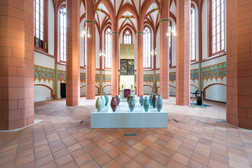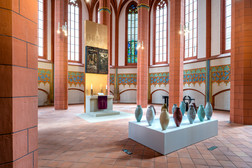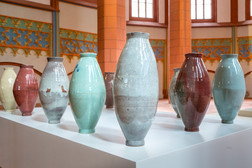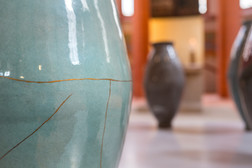Young-Jae Lee: Vasen
Chemnitz
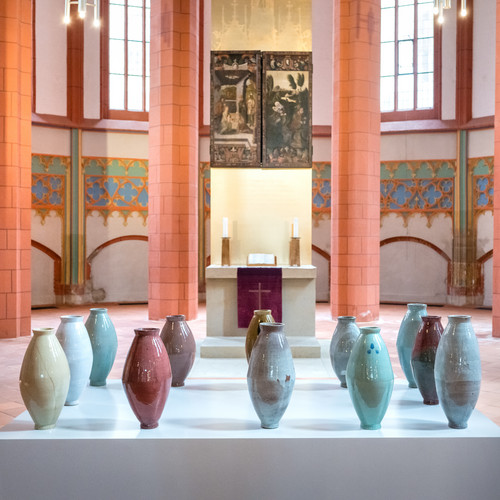
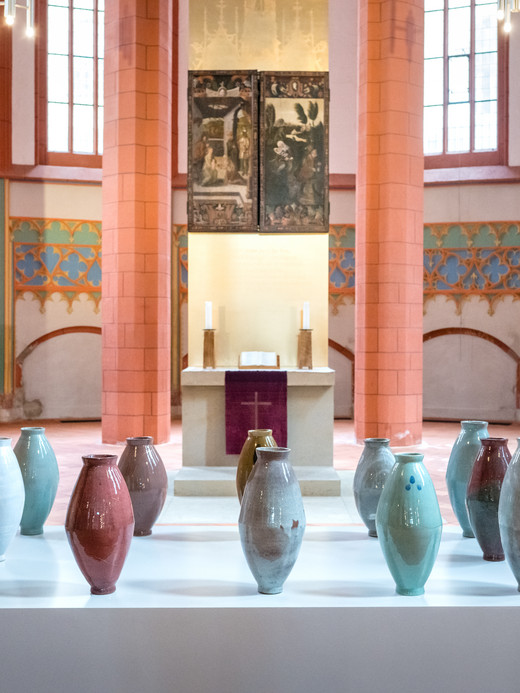
Korean-born Young-Jae Lee (*1951, Seoul) has been a pioneer in the world of artistic ceramics for fifty years. She studied in Seoul at the College of Art Education (1968-1972) and ceramics and design at the University of Applied Sciences in Wiesbaden (1973-1978). She initially opened her own workshop in Sandhausen/Heidelberg, and since 1987 she has run the Margaretenhöhe Ceramic Workshop in Essen, which was founded by Margarete Krupp. In addition to numerous prizes, the artist received an honorary doctorate from the Eugeniusz Geppert Academy of Art and Design in Wrocław in 2016.
Young-Jae Lee's work centres on vessels and large-format bowls, which she arranges into various installations in her exhibitions, often temporarily redefining her exhibition spaces in the process. The works have already been shown worldwide. The artist wants to create bowls and vases made of clay "as the world has never seen them before". 49 different colourfully glazed pieces will now be on display in Chemnitz in the Stadtkirche St. Jakobi, once again bringing secular art into churches.
Young-Jae Lee
Vases
In Chemnitz
Material: Ceramic
Address:
City and Market Church of St Jakobi
Jakobikirchplatz 1
09111 Chemnitz
to the location on Google Maps
Chemnitz - the locomotive of Saxon industry
Schillerplatz, the location of the sculpture Oben-Mit by Osmar Osten, tells us a lot about the last 200 years of the city's history. The square itself and key buildings in its architectural surroundings are striking milestones in the city's development. Schillerplatz was once the largest urban green space in Saxony. It was laid out in 1858, one year before the 100th birthday of the poet Friedrich Schiller. It was a time of profound transformation of the city's topography, as Chemnitz had been growing since the 1830s with the industrialisation of the city Industrialisation at a breathtaking pace with industrialisation.
The age of machines
Textile goods and textile machine construction, machine tools and locomotives in particular led to an extraordinary increase in production. Favourable conditions were created by joining the German Customs Union in 1834, the development of hard coal in the Lugau-Oelsnitz and Zwickau coalfields for steam engine drives and the construction of the Saxon railway from 1850.
in 1826, Carl Gottlieb Haubold began building spinning machines. His Sächsische Maschinenbau-Compagnie (1836) is regarded as the nucleus of industrial engineering in Chemnitz. The city acted as a magnet for inventors and entrepreneurs. The locksmith Johann Zimmermann, who moved here from Hungary in the 1830s, founded the first machine tool factory. In 1840, the inventions of the Plauen-born designer Louis Schönherr led to the factory production of the mechanical cloth loom.
Technical education and mobility
From 1836 onwards, many skilled workers were needed, who were trained at the Königliche Gewerbeschule, now the Technical Universitywere trained. Its main building is located to the east of Schillerplatz on the Straße der Nationen. in 1848, Richard Hartmann, an immigrant from Alsace, manufactures the first locomotive and becomes the main supplier to the Royal Saxon Railway. By the end of the 1920s, almost 4,700 units had been delivered worldwide. The Chemnitz railway stationa few minutes' walk east of Schillerplatz, was opened in 1852. Today's historicist-style station building dates back to 1872.
Factories, prosperity and culture
To the north, Schillerplatz is bordered by the Chemnitzer Aktienspinnerei Chemnitz stock spinning mill built in 1858. It was once considered the most modern and largest factory in Saxony: architecturally, because it was built entirely of stone and iron; industrially, because it had enormous production capacity. A core part of the building was renovated in 2020 and is now home to the University library and archive.
Between 1870 and 1914, Chemnitz was one of the largest industrial metropolises in Germany, growing from 100,000 to 320,000 inhabitants. In terms of population and tax revenue, it was considered the wealthiest German city. The growing prosperity created a cultural milieu in the city: newspapers and a library, associations for history, science, art and literature, a singing academy and secondary schools, civic lecture, exhibition and collection activities. An example of this is the theatre square, which adjoins Schillerplatz to the south: with the Central-Theater (1906-1909), since 1925 Opera houseflanked by the Petrikirche (1885-88) and the König-Albert-Museum (1898-1908), today the Municipal art collections.
City of modernity
These developments continued into the 1930s and beyond Schillerplatz and its surroundings in other neighbourhoods, establishing Chemnitz's reputation as a "city of modernism":
- from 1855: production of bicycles, milling machines, typewriters and calculating machines in the Wanderer factories
- 1860-1930: Neo-Romanesque, Neo-Renaissance and Art Nouveau in the Gründerzeit neighbourhood of Kaßberg
- 1903: Henry van de Velde builds the Villa Eschefor a textile entrepreneur
- from 1905: Expressionist avant-garde art by Karl-Schmidt-Rottluff, Edvard Munch and Otto Dix in the art collections
- 1927: Architect Erich Basarke designs an industrial complex for Schubert&Salzer, today's Wirkbau
- 1930: Architect Erich Mendelsohn builds the Schocken department stores', now the State Museum of Archaeology
- 1930: Architect Fred Otto designs the new Sparkasse building, now the Gunzenhauser Museum of 20th Century Art.
Chemnitz - Karl-Marx-Stadt and back: two new beginnings
Today, Schillerplatz is no longer a full-sized park, but is divided into two parts. Its northern area is home to the Bus station. It was created in the 1960s when the GDR decided to rebuild the city centre, 90 percent of which had been destroyed in 1945 during the Second World War, with socialist architecture.
Chemnitz had already been called Karl-Marx-Stadt since 1953 and was to be transformed into a socialist metropolis, as the prefabricated buildings from the 1970s/80s to the west of the square show. The Straße der Nationen, which is tangent to Schillerplatz to the east, leads right into the centre with its modern GDR buildings. The monumental 40-tonne bronze Marx head by Lew Kerbel (1971) is also part of this transformation.
With German reunification in 1990, the city began to reinvent itself. The city was renamed Chemnitz in a referendum. For three decades, a lot of building has been going on, gaps left by the destruction of the war have been closed and architectural monuments have been restored. Around the Red Tower from the 12th cent. a new city centre has grown up around the 12th century Red Tower, which attempts to form a link between the Old Town Hall (1496-98) and the New Town Hall (1907-11) as well as the socialist buildings Hotel Congress and Town hall from the years 1969-74.
In 2023, in anticipation of the Capital of Culture year, the city council decided to upgrade the landscape architecture of Schillerplatz, which is close to the city centre. Osmar Osten's sculpture as part of the Purple Path, which symbolically connects Chemnitz with the region as Capital of Culture, is an important step in this direction. The rich historical tree population is to be preserved and the network of paths renewed.
Roots of the city in the 12th century: Benedictine monastery and Red Tower
Visitors to Chemnitz today will only notice in a few places that the city's history goes back several centuries further than the boom years of industrialisation and modernity. A document from the Hohenstaufen Emperor Conrad III from 1143 attests to the granting of market privileges to a Benedictine monastery. This was located in a place called "Chemnitz" (Latin "locus Kameniz dictus"). The monastery was founded by its predecessor, Emperor Lothar III.
The earliest parts of the monastery church (now the castle church) date back to the 1160s. With the imperial market rights, a settlement was established in the vicinity of the monastery, traces of which have been found by archaeologists and dated to around 1200. An old interest register, which records the taxes paid by the settlement to the monastery, confirms the findings. From the 1250s, there is documentary evidence of the parish church of St Jakobi, which stands next to the Old Town Hall (15th century) on the market square. The foundations of the Red Tower in the centre of Chemnitz, part of the city fortifications, also date from this period.
This outlines the early cornerstones of the imperial city of Chemnitz in the Middle Ages. The town must have quickly established itself economically. From the 14th century onwards, we know for certain of extensive linen weaving and a bleaching privilege (1357). This meant that the regional value chains became dependent on the Chemnitz textile market for many centuries.
The flow of money to Chemnitz aroused covetousness, making the city a pawn in the hands of various interests. Emperors, monastic abbots and the Margraves of Meissen vied for influence for two centuries. It was only with the emergence of Saxon sovereignty that the town came under the permanent influence of the Wettin dynasty in 1423, but retained its freedoms and privileges.
Worth seeing about this early history of the town is the Castle Hill Museum.
Early capitalism and the new faith: the textile industry, the mining industry and the Reformation
Bleachers and cloth merchants made big business in Chemnitz. Textiles remained the dominant industry for centuries, establishing early industrial manufactories as early as the 18th century. With the mining boom in the Westerzgebirge, money was also invested in the mining industry. We know of investments in mines in nearby Geyer, of a Saiger smelter (1471), which smelted copper and silver from ore rock, and of a copper hammer (around 1470) in the city of Chemnitz.
The citizens of Chemnitz developed a high level of self-confidence and attempted to emancipate themselves from the monastery in the second half of the 15th century, both in economic and religious terms. Wealthy citizens founded a Franciscan monastery in the town area, cultivated new forms of piety and refurbished the town churches. The tax policy, lifestyle and understanding of service of the Benedictines on the mountain above the town were criticised. All of these were the first harbingers of what we call the Reformation in historical retrospect.
Late Gothic church building, summer residence and art collection
Abbots Heinrich von Schleinitz (1484-1522) and Hilarius von Rehburg (1522-40) attempted to counteract these developments. The Romanesque church was lavishly rebuilt into a three-aisled hall church with late Gothic elements (choir consecration in 1499), apparently in order to set a new example of a new beginning: tall, slender pillars support a decorative ribbed vault.
The furnishings with sacred art are also worth seeing: St Catherine's altar (1499, on permanent loan from Großenhain), north portal with figures by Master HW (1525), four painted panels from a former altar by Lucas Cranach the Elder (1518/20) and the famous oak flagellation column by Master HW (1515).
the Reformation was introduced in 1539/40 and the Benedictine monastery was dissolved. Duke Henry the Pious rebuilt the area into a residential castle in 1548/49, hence the current name of the area: Schloßberg. Today it is home to the Schloßberg Museum. The reconstructed monastery rooms (cloister, refectory, chapter house and parlatory) house an important collection of sacred art with works by the master HW, Hans von Cöln, as well as the extraordinary Holy Sepulchre and Meissen-Saxon panel painting.
